| 🔍 > Lean Terms Directory |
Standard Work
In Lean, Standard Work is the cornerstone of any continuous improvement effort. It locks in gains and provides a foundation for future advances. It helps companies reach their improvement targets, but also provides a stable, reasonable working environment for frontline employees. Learning how to standardize a process using this tool is one of those things that is easy to do at a basic level. Going beyond that rudimentary understanding, though, is something that few people, and companies, ever succeed in doing.
The simple definition of Standard Work is that it is a formally defined and documented process to produce at a specified pace. It has three main components:
- It is balanced to the takt time.
- It specifies standard work-in-process (WIP).
- It defines the sequence of operations for a single operator.

Let’s start off by briefly reviewing how standards, standardization, and Standard Work all fit together. Standards establish the rules for how something is done (i.e. OSHA has guidelines about what protective gear employees have to wear and how much they can lift) or define the expected outcome of a process (i.e. level of quality).
Standards are met by using standardization—making repeatable processes. There are many ways to standardize a process: company procedures (i.e. how to request a day off), checklists, flowcharts, work instructions, etc.
Standardization aims to remove variation in order to create consistency. It ensures that the process is done the same way every time, no matter who does it. If a process is only followed sporadically, then it isn’t really standardized. In order for standardization to be effective, it has to be communicated and it has to be enforced.
Before the front line reads that and thinks, “Great, just another thing I have to do,” enforcement works both ways—leaders have to adhere to standardization as well. That means that if the process documentation says an employee needs twelve minutes to do a task, the boss can’t expect it done in eight. Leaders have to follow standardized processes too.
Standard Work is a very specific type of standardization. Let’s take a closer look at the components of Standard Work.
Components of Standard Work
- Standard Work is balanced to the takt Takt time is the pace of production that is needed to meet customer demand. If Standard Work has you producing faster than takt time, you have extra capacity, and are overproducing. If Standard Work has you producing slower than takt time, your customers are waiting for products, if they can get them at all.
In sophisticated systems, you may see several different versions of Standard Work, each balanced to a different takt time. When demand rises or falls, the adjusted takt time determines which version of Standard Work the team uses.
- Standard Work specifies standard work-in-process (WIP). If the number of items that a person is working on varies from cycle to cycle, there is no consistency. If you build two widgets one time and seven the next, there won’t be a steady delivery of parts to the downstream customer. Consistency and predictability lie at the heart of flow (the steady movement of work units through a production process), so the number of work pieces should be clearly defined.
A basic rule of thumb is that there is a single piece of WIP for each operator (or team if two or more people are working together), plus one piece for each machine that does automatic processing of a part. This lets the machine do its job on one piece while you do your job on another.
Standard WIP can be established as an individual item or as a set, like four tires. If production is done for a complete set, the process should still define the sequence of work (i.e. whether each tire is prepped completely, or each step is done for all four tires before moving on to the next task).
- Standard Work defines a single operator’s sequence of operations. The sequence of operations matters. In some cases, doing the steps in the wrong order can create a dangerous situation. In other cases, quality could be compromised. In addition, changing the sequence of operations usually changes the time it takes to complete, potentially making the cycle time exceed takt
Why do I say, “single operator”? Does that mean that people can’t work as a team in a work area? Not at all. It just means that each team member will be assigned his own specific tasks. The best example of this type of sequencing is on a pit crew. What if the tasks were loosely defined and the team didn’t have specific duties? Two people would be going for the gas can, and nobody would be cleaning the windshield—adding precious seconds to the time off the track.
Once Standard Work is established, you can start stabilizing the physical layout of a work area. You can define tool locations and move parts bins right where they are needed. Standard Work and 5S go hand-in-hand. As the locations get refined, walking distance goes down (reducing transportation waste), improving productivity, and reducing fatigue.
Here’s a challenge you will likely face: in the early stages of any transition, you will encounter the chicken-or-the-egg dilemma. If you try to implement Standard Work in an area with a lot of production problems or quality issues, you will have a difficult time establishing a stable process. If you try to solve the problems first, you are chasing a moving target, and it can be hard to resolve them.
Instead, start out by going after any of the low hanging fruit that you can find—the easy problems that take relatively little time and effort to fix. But set a deadline for when you will start your Standard Work. That way, you give yourself a better chance of success, but don’t delay things. Think better, not perfect.
So, once Standard Work is established, what is it supposed to do for you?
- It provides consistency that lets your company plan its lead time You know exactly what will be coming off the end of an assembly line, and you know exactly when.
- It provides a basis for improvement. Since everyone is doing the process the same way, it gets easier to make changes that stick. Plus, the physical layout can be arranged to support the process.
- It improves quality. When inputs are consistent, so are outputs.
- It improves morale. Expectations become clear, making relationships between leaders and frontline employees better.
- It prevents backsliding. It becomes much harder to go back to the old way when Standard Work is established.
- It makes problems apparent. Whenever there is a glitch that keeps Standard Work from flowing smoothly, it is easy to see.

Standard Work is only effective if it is used. Problems can derail it if they are not recognized and addressed.
- Standard Work is not perfect. There will be intermittent problems in the process and you will need to figure out how much time you want to add in to solve them when they happen. If there is a lot of extra time built into the process, it will make the operation inefficient whenever the problem doesn’t Generally, extra time that is built into a process “temporarily” never gets removed. But if you don’t have any extra time built in, you will need a reaction plan with stopgaps that you can use whenever you identify an abnormal condition. You’d then put a countermeasure in place to deal with the issue permanently. On the shop floor, these reaction plans are often triggered by an andon light.
- Standard Work is not permanent. It can, and should, change regularly. In fact, you may see more frequent changes in a process after it is standardized than before. Once there is stability, process improvement happens at an increasing pace.
- Use a stopwatch to resolve disputes. No sense in getting angry at a coworker, especially when there is a very simple way to identify which process works best.
- Administrative processes provide a special challenge for Standard Work. Standard Work is a very specialized kind of standardization useful in very specific situations. In the office, it is rare to find a situation that works perfectly with Standard Work. Instead, office workers should focus on using other forms of standardization to reduce variation in processes as much as possible. Standard Work relies on a consistency of inputs that is just not present in most offices.
That doesn’t mean that it isn’t a good goal to get Standard Work in the office. Customer behavior is usually the biggest culprit in the variation that prevents Standard Work. But even this can be adjusted. Customers in grocery stores have been trained, right? They go to the lanes with the lights on, and they self-select—those with fewer than 15 items go in the express lanes. As customer behavior is standardized, processes have less variation. Be careful, though. Make sure that your changes serve your customers, rather than irritate them.

Standard Work, on the surface might sound like a bum deal for you. You lose flexibility in how you do your work. You have to do the same thing day in and day out, making your job boring. You are always on the clock, which makes you feel pressured.
Of course, that’s only one way of looking at Standard Work. There is also another, more positive way of looking at it.
If everyone is using this tool, the quality of parts you receive will be higher, making your job easier. The pace, though constant, should be manageable. There is a lot less sprinting when customer orders pick up. You see more opportunities for improvements, since the work area starts to support the work. You have more input to changes in your job—Standard Work provides an avenue for you to alter work processes. Learning multiple jobs is easier when processes are standardized. The list goes on and on.
An observation for you: many people who initially balk at Standard Work grow to love it when they become receptive to the benefits that it offers.

Exclusive Content for this Section is available at academy.Velaction.com

Key Points to Consider about Standard Work
- It is a specific form of standardization.
- It is a cornerstone of Lean.
- It should be balanced to takt
- It is a contract that has to be followed by both employees and bosses.
![]()
Get the Standard Work Sheet, Time Observation Sheet, and Standard Work Combination Sheet and start documenting your processes. The simple act of observing processes often highlights differences in the way people do the same job. This can drive immediate improvement as the best practices already in use are combined.
![]()
You will see Standard Work documented on three basic forms.
- Standard Work Sheet. This sheet is an overview of the work area. It may show more than one operator on the same page to show how they interact, but generally, each operator will have his own sheet. The numbers should correspond to the steps on the Standard Work Combination Sheet. An astute observer may notice that there is only one piece of WIP, despite using an automatic juicer. In this example, the operator mixes other ingredients while the juicer is running, so there is no need for additional WIP. That same observer might also identify the backtracking at Step 5 as an improvement opportunity. (Get a free Standard Work Sheet Template.)
Sample Standard Work Sheet from the book Whaddaya Mean I Gotta Be Lean? 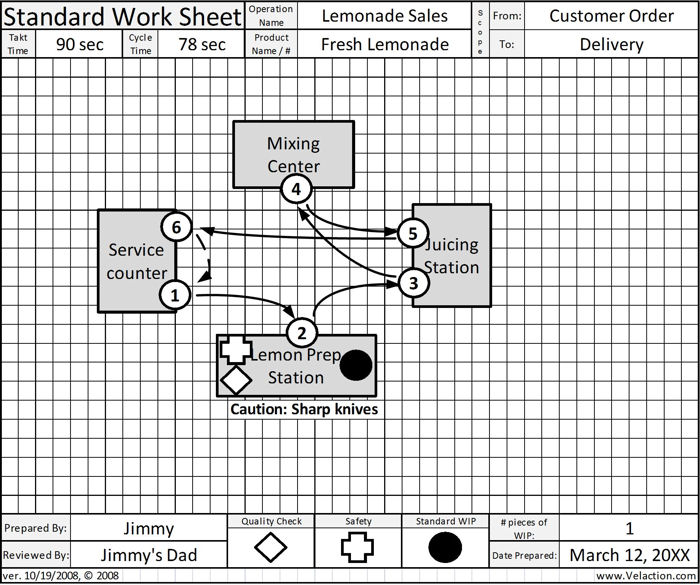
- Standard Work Combination Sheet. This sheet shows the interaction of an operator (one per page) and machines, depicts walking, and demonstrates how well the station is balanced to the takt
It is also very useful for identifying improvement opportunities. Longer tasks draw attention to themselves—they normally have the most waste. Long periods of walking also catch the eye. (Get a free SWCS template.)
Sample Standard Work Combination Sheet from Whaddaya Mean I Gotta Be Lean?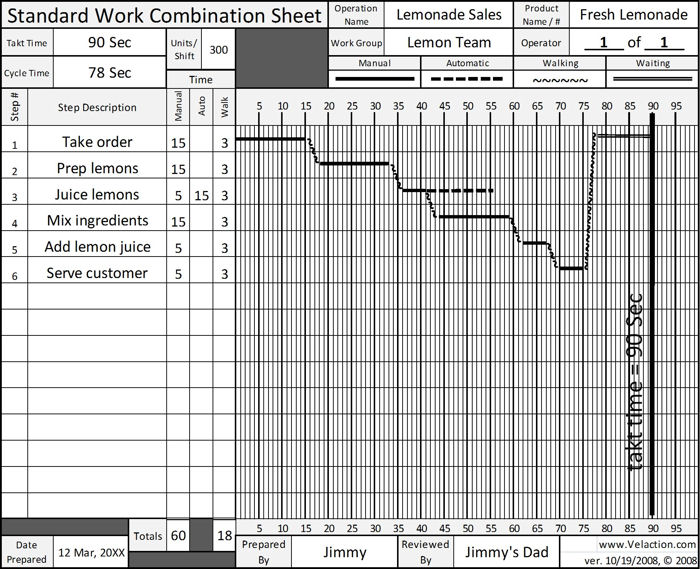
- Work Instructions. Not truly a part of Standard Work, but important nonetheless. Individual steps may have specific, detailed instructions that are not contained in the Standard Work Sheet. If you have a 27:12 takt time to make go-carts, and the wheel installation step is 4:08, you might leave that as a single step on the Standard Work Sheet but break it down into detail in the work instructions. Determining the appropriate level of detail is one of those judgment calls that has no real right answer. A general rule of thumb is to try to keep the Standard Work Combination Sheet to one page. When pages don’t have to be flipped, it makes the entire document more likely to be looked at. Plus, the whole work flow can be more easily seen at a glance when posted in a work cell. The detailed information is, instead, documented on the work instructions. The format for work instructions varies widely, from basic flowcharts on up to company-specific forms that detail steps, motions, parts, tools, and any required specifications (i.e. torque).
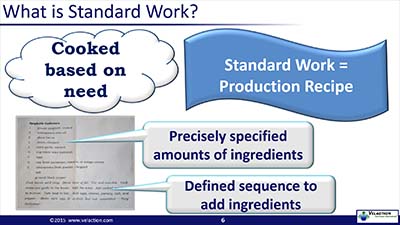
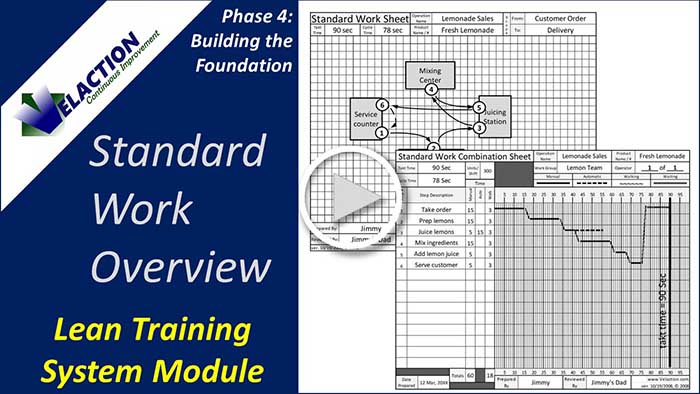
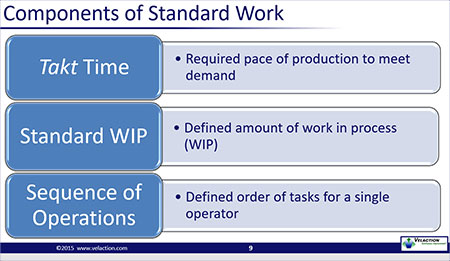
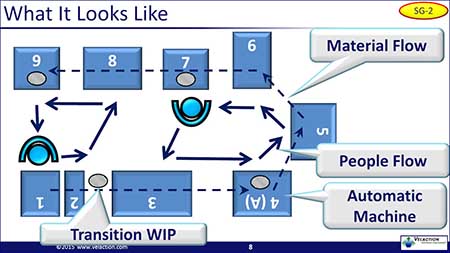
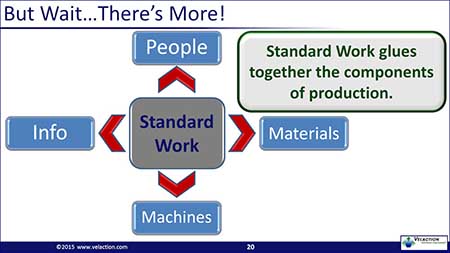
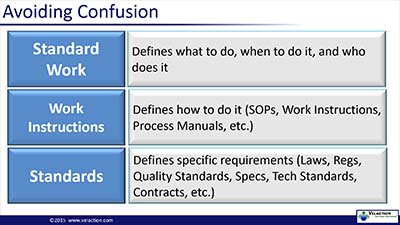
2 Comments
Jess · September 9, 2011 at 8:33 pm
Nice article would like to see if you can send me some templates on standard work
Regards
Jeff Hajek · September 10, 2011 at 9:20 am
Jess,
I have several forms available for download. Go to the forms page (the icon is in the header), and sign in to get what you need.
Thanks for the comment.
Regards,
Jedd